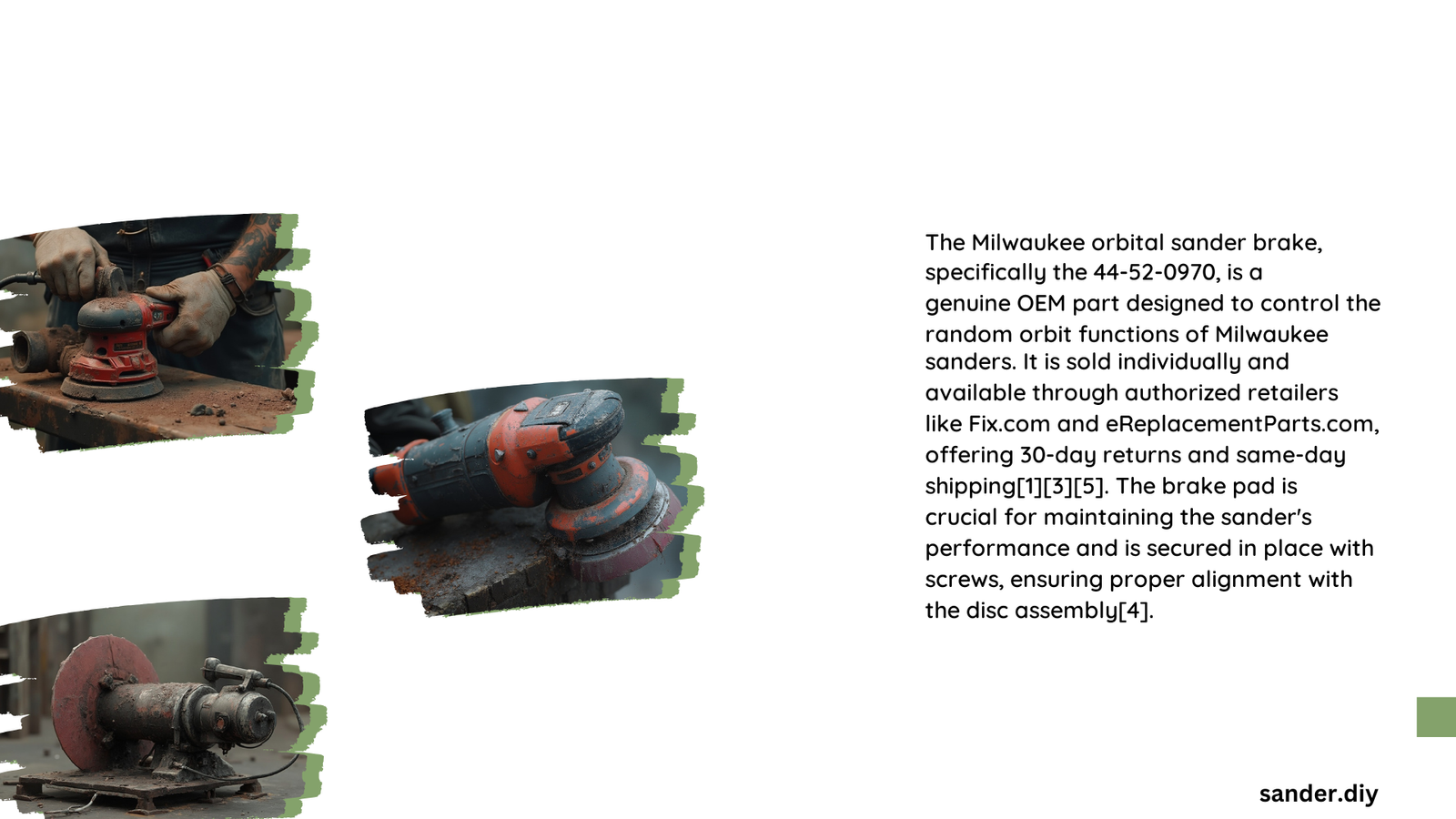The Milwaukee orbital sander brake is a crucial component that controls the random orbit functions of the sander. It prevents the sanding pad from rotating at high speeds when not in contact with the work surface, ensuring safety and precision. This brake system, primarily managed by a brake pad, is essential for maintaining control during sanding operations and quickly stopping the pad when the sander is turned off or lifted from the workpiece.
What is the Purpose of the Milwaukee Orbital Sander Brake?
The Milwaukee orbital sander brake serves several important functions:
- Speed Control: It regulates the rotation speed of the sanding pad.
- Safety: Prevents uncontrolled spinning when the sander is lifted.
- Precision: Allows for more accurate sanding by preventing over-speeding.
- Quick Stopping: Ensures the pad stops spinning rapidly when the tool is turned off.
How Does the Milwaukee Orbital Sander Brake Work?

The brake system in the Milwaukee orbital sander operates through a simple yet effective mechanism:
- Brake Pad: The primary component responsible for braking action.
- Housing Slots: The brake pad fits into these slots for proper alignment.
- Friction: When engaged, the brake pad creates friction to slow and stop the pad rotation.
The brake engages automatically when the sander is lifted from the work surface or turned off, providing instant control over the tool’s operation.
What Are Common Issues with the Milwaukee Orbital Sander Brake?
Users may encounter several problems with their Milwaukee orbital sander brake:
- Delayed Braking: The pad continues to spin longer than usual after lifting or turning off.
- Inconsistent Stopping Power: Variations in how quickly or effectively the pad stops.
- Excessive Wear: The brake pad wears out faster than expected.
- Misalignment: The brake pad doesn’t fit properly in the housing slots.
These issues can often be resolved through proper maintenance or replacement of the brake pad.
How to Troubleshoot Milwaukee Orbital Sander Brake Problems?
Follow these steps to diagnose and resolve brake issues:
- Inspect the Brake Pad:
- Check for visible wear or damage
-
Ensure it’s properly seated in the housing slots
-
Test Braking Performance:
- Turn on the sander and lift it from a surface
-
Observe how quickly the pad stops spinning
-
Check for Debris:
- Clean the area around the brake pad
-
Remove any dust or debris that might interfere with operation
-
Verify Power Supply:
- Ensure the battery is fully charged (for cordless models)
- Check the power cord for any damage (for corded models)
If these steps don’t resolve the issue, consider replacing the brake pad.
What is the Process for Replacing the Milwaukee Orbital Sander Brake?
Replacing the brake pad is a straightforward process:
- Gather Materials:
- New brake pad (Part Number: 44-52-0970)
- Screwdriver
-
1 Slotted screwdriver (optional)
-
Remove Sanding Pad:
-
Unscrew and remove the sanding pad
-
Replace Brake Pad:
- Take out the old brake pad
- Align the new pad with housing slots
-
Gently work it into place (use #1 slotted screwdriver if needed)
-
Reassemble:
-
Reattach the sanding pad securely
-
Test:
- Turn on the sander to ensure proper brake function
What Are the Specifications of the Milwaukee Orbital Sander Brake?
| Specification | Detail |
|---|---|
| Part Number | 44-52-0970 |
| Estimated Cost | $2.94 per pad |
| Compatibility | M18™ 5\” Random Orbit Sander |
| Material | Plastic |
| Installation | DIY-friendly |
How to Maintain the Milwaukee Orbital Sander Brake for Longevity?
To ensure long-lasting performance of your Milwaukee orbital sander brake:
- Regular Cleaning:
- Remove dust and debris after each use
-
Use compressed air to clean hard-to-reach areas
-
Periodic Inspection:
- Check the brake pad for wear every few months
-
Look for any signs of damage or misalignment
-
Proper Storage:
- Store the sander in a dry, dust-free environment
-
Avoid leaving it in extreme temperatures
-
Timely Replacement:
- Replace the brake pad at the first signs of significant wear
-
Don’t wait for complete failure before replacing
-
Correct Usage:
- Avoid applying excessive pressure when sanding
- Let the tool do the work to prevent unnecessary strain on the brake
By following these maintenance tips, you can significantly extend the life of your Milwaukee orbital sander brake and ensure consistent performance.
What Are User Experiences with the Milwaukee Orbital Sander Brake?
User feedback on the Milwaukee orbital sander brake has been generally positive:
- Effectiveness: Many users report significant improvements in braking performance after replacing worn-out pads.
- Material Versatility: The brake works effectively across various materials, particularly noted for wood.
- Ease of Replacement: Users find the brake pad replacement process straightforward and manageable.
- Performance Restoration: Several users mention that a new brake pad makes their sander work like new again.
However, some users have noted:
- Wear Rate: The brake pad may wear out faster with heavy use.
- Alignment Challenges: Some users find it tricky to align the new pad perfectly in the housing slots.
Overall, users appreciate the brake’s role in maintaining control and precision during sanding operations.
Where to Purchase Replacement Milwaukee Orbital Sander Brake Pads?
Replacement brake pads for Milwaukee orbital sanders can be purchased from several sources:
- Official Milwaukee Tool Website
- Authorized Milwaukee Tool Dealers
- Online Marketplaces (e.g., Amazon, eBay)
- Specialty Tool Repair Shops
- Home Improvement Stores (e.g., Home Depot, Lowe’s)
When purchasing, always ensure you’re getting the correct part number (44-52-0970) for compatibility with your specific Milwaukee orbital sander model.
By understanding the function, maintenance, and replacement process of the Milwaukee orbital sander brake, users can ensure optimal performance and longevity of their tools. Regular inspection and timely replacement of the brake pad are key to maintaining the sander’s efficiency and safety during operation.
References:
1. Milwaukee Tool – M18™ Random Orbit Sander
2. eReplacementParts – Pad Brake 44-52-0965
3. Quagmire Repair – Milwaukee 44-52-0970 Plastic Brake Pad
